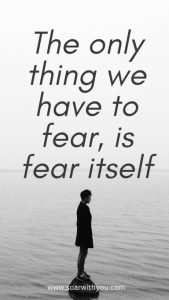We’ve all faced some fears and are continuously fearful of one thing or another. The fear of heights, fear of losing a job, fear of losing loved ones, fear of public speaking, fear of heights or flights, fear of failure, and on and on. Fear is an emotion like any other and it’s actually good as it gives you a chance to take flight or run away from something unpleasant or something dangerous. However, not all fear warrants a similar reaction.

There’s a fear that paralyzes you from achieving greater things and stops you from achieving your purpose.
There are 4 elements of fear; uncertainty, attention, change, and struggle. Most fear stems from these four elements.
Uncertainty is when you have to do something you’re not sure about, or how to do it, and you’re not sure how it shall be received by others. This can cause fear and your next response will determine your altitude.
Attention is best described in public speaking or when answering a question in a class or in a meeting. When you raise your hand to make a response, all eyes turn to you, and this can bring about fear. Thoughts of, what if I say something stupid, what if I am wrong, begin to flood your mind, and again your response to this fear determines the next course.
Change, our bodies love routine, right from the time we are born. Change is never comfortable and therefore your mind will always resist change. But we know that change is actually the only constant in life.
Struggle, we all don’t like to struggle, therefore when action seems to be accompanied by a struggle, we automatically get into fear mode, whether the struggle is real or imagined.
There are different opinions about fear, like Sadhguru, who suggests that fear is not real. He says that fear is a result of excessive imagination of what may happen, and it’s all in your mind. He suggests that these imaginations are for things that will mostly never happen. Whether fear is real or not, I think, is a philosophical question; but the emotion of fear is definitely real. More so, we also know that the thing you fear the most might actually never happen. So how do you overcome this fear?
Do it Afraid
Joyce Meyer says, “step out and find out”, failing at something and being a failure are two different things, when you fail at something, at least you'll have tried. Being a failure just means you never tried anything. She speaks in depth on fear in her book ‘Do it Afraid”, and says the antidote to fear is faith. This is very true, sometimes you just need to believe against your fears, and act, just do it afraid, and in faith.
Want to start a new project but are afraid? Start doing it, do it afraid.
Don’t fight it
Another way to conquer fear is by not fighting it, someone said to 'dance with the fear’, listen to it but do the opposite. Don’t let fear take the driver’s seat, let it seat in the back seat to keep you in check but do take the wheel. One suggestion for conquering a fear or uncomfortable situation is what Tim Ferris gives in his book the 4-Hour workweek, as challenges, he asks the reader to get into a normally uncomfortable situation and do the thing that they fear.
If you have an unreasonable fear of heights, go climb a high space, are you afraid to speak out against or for something? Do it anyway.
Face your fear
Feeling fear before something that stretches us, is human and natural. How you handle that fear is what counts. Those with little children that have a fear of darkness might know this, when your child is afraid of the boogieman under their bed, the best way to help them is by lighting up the room and showing them under the bed, that there's nobody. They actually 'face' the boogieman in the process and discover he really isn't there.
Are you fearful to approach a certain individual or to point out something to someone? What’s the worst that can happen? Are you afraid of asking for help? The more you ignore your fears, the more they shall paralyze you.

5 Second Rule
Mel Robbins talks about the 5-second rule in overcoming her public speaking anxiety, where she counts downward from 5, then gives herself self-talk. Neuroscience has told us the brain cannot distinguish reality and imagination, and thus cannot differentiate the feeling of fear and excitement. In Mel Robbins’ 5-second rule, she uses this analogy to tell herself ‘I’m so excited to be doing this presentation”. This helps her to trick her brain that she’s actually not fearful but excited.
Use your imagination
Another technique I’ve used in different scenarios is the use of thought and imagination. Imagine yourself having accomplished something you were afraid of and are now receiving the fruits of your 'labor', or imagine yourself having reached your destination, for those with a fear of flying. Your brain adjusts to this feeling, telling your nerves that all is well.
We can all agree that the majority of the things we fear, will never even happen. Just look at how far you've come and the fears you had before you reached where you are now. Aren't you glad your fears did not win?
The heaviest burden we carry is the thoughts we carry in our heads, the unreasonable fears that rob us of our future.

